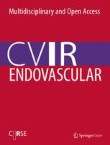CVIR Endovascular is an official journal of the Cardiovascular and Interventional Radiological Society of Europe
Use of heparinized saline flush during endovascular thrombectomy for acute ischemic stroke; a survey of clinical practice in the Netherlands
Information about optimal use of heparin in flush fluids during endovascular thrombectomy (EVT) for acute ischemic stroke (AIS) is lacking. Variables that determine total heparin dose entering the patient by f...
